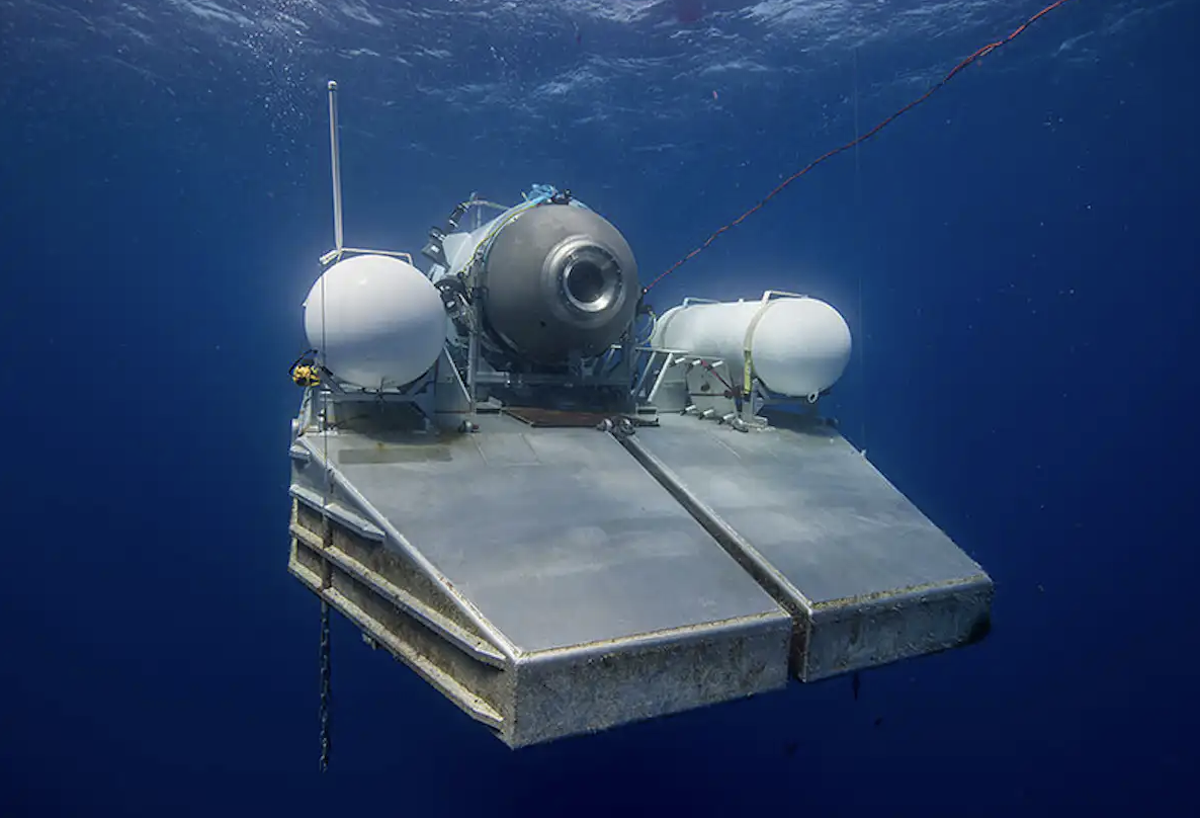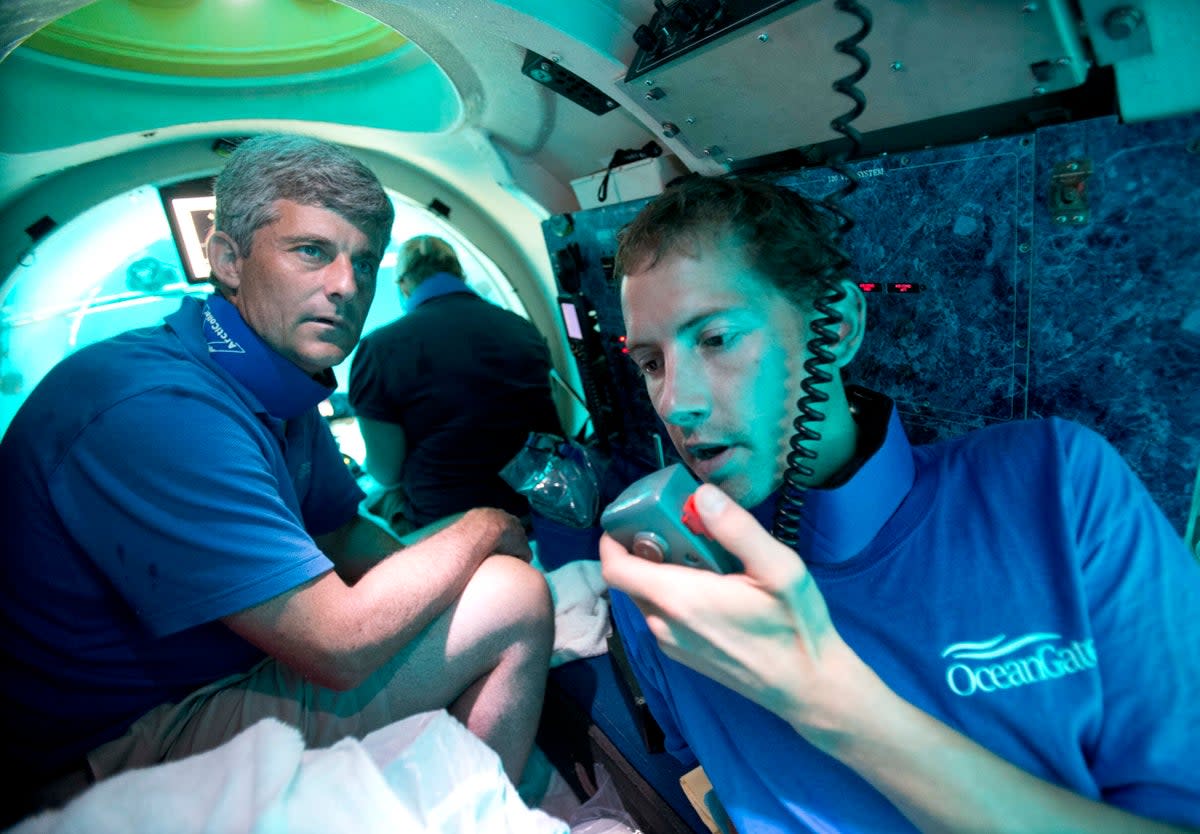Radio silence, escape options and ‘banging’ sounds: Five unanswered questions in the Titanic sub rescue
A deep-sea faring submersible vessel that disappeared on an expedition to the Titanic wreckage site is believed to have less than 12 hours of oxygen left - as rescue crews appear no closer to finding it.
The Titan, a five-person capacity vessel run by OceanGate Expeditions, vanished without a trace about 100 minutes after launching from the Polar Prince icebreaker research ship about 900 miles off the coast of Cape Cod on Sunday morning.
A sweeping search effort involving Canadian Boeing P-8 Poseidon and C-130 Hercules reconnaissance aircraft and underwater sonar buoys has failed to find any sign of the vessel, US Coast Guard Captain Jamie Frederick said in a briefing on Tuesday.
However, the French ship Atalante carrying the Victor 6,000 underwater (ROV) and winch — the only one capable of reaching the Titanic wreck 4,000m under the ocean surface — will have a narrow window of time to conduct potential rescue operations as it is only expected to reach the search site on Wednesday night.
Follow live coverage of the missing Titanic sub in our live blog here
British billionaire explorer Hamish Harding and French diver Paul-Henri Nargeolet — known as Mr Titanic — are onboard, along with Pakistani businessman Shahzada Dawood and his 19-year-old son Sulaiman Dawood.
OceanGate Expeditions confirmed its CEO and founder Stockton Rush was the fifth person aboard on Tuesday.
More than 72 hours after the vessel vanished, many troubling questions remain.
Why did the submersible go offline?
The Titan uses two systems to communicate with its surface ship. Text messages can be sent back and forth, and safety pings are emitted every 15 minutes to indicate the sub’s location and that it is still functioning.
Both systems stopped working about an hour and 45 minutes after the Titan submerged on Sunday morning.
According to its website, OceanGate developed a Real Time Hull Health Monitoring (RTM) safety feature that assesses the integrity of the Titan’s hull throughout every dive.

The technology can likely gauge any weaknesses in the Titan’s carbon fibre hull and transmit the data to its five-person crew and the support ship on the surface.
The hull connects two titanium domes that are specifically built to withstand the extreme pressure from the weight of the water at 4,000m below sea level.
OceanGate Expeditions revealed earlier this month that Elon Musk’s Starlink satellite company was providing it with internet connection.
What could have happened to the Titan?
Experts across the industry have offered three potential theories, the most dire being that it imploded under immense pressure. It’s also possible the vessel got trapped in the wreckage, or reached the surface and is lost afloat.
The sudden loss of contact by the Titan’s twin communications systems was an ominous sign, according to longtime tech journalist David Pogue, who travelled to the famous wreck site onboard the Titan in 2022.
“There are only two things that could mean. Either they lost all power or the ship developed a hull breach and it imploded instantly. Both of those are devastatingly hopeless,” Mr Pogue told CBC on Tuesday.

Alistair Greig, a professor of marine engineering at University College London, told the Associated Press that another possibility was a leak in the Titan’s pressure hull.
If the vessel had reached the ocean floor and couldn’t return on its own, “options are very limited,” he said.
“While the submersible might still be intact, if it is beyond the continental shelf, there are very few vessels that can get that deep, and certainly not divers.”
Underwater currents
Another possibility is the Titan came into contact with the wreckage of the Titanic, and became stuck or had its onboard systems disabled.
The period between entering the water and when it lost contact would roughly correspond to the length of time it would take to reach the wreckage site.
Former ABC News science editor Michael Guillen, who was the first journalist to visit the Titanic wreck site in 2000, shared his own near-death experience after the submersible he was in became caught in an underwater current.
Mr Guillen said a strong ocean rip pushed the vessel towards the Titanic’s 21-tonne propellers, and became wedged under its stern.
The crew of the Mir 1 submersible then frantically tried to reverse out, and appeared to collide with the famous shipwreck.
After 30 minutes of moving backward and forward, the crew eventually managed to free the vessel and return to the surface.
Mr Guillen later wrote in his 2021 memoir Believing is Seeing that he thought he was going to die.
The Canadian military has dropped sonar buoys into the water that would likely be able to detect distress signals made by the five-person crew, if they hadn’t been incapacitated.
What are the ‘banging’ sounds detected?
On Tuesday, bouys detected “tapping sounds” coming from the search area, raising slim hopes that survivors could yet be found.
“We don’t know the source of that noise, but we’ve shared that information with Navy experts to classify it,” US CoastGuard Rear Admiral John Mauger told CBS This Morning.
The sound was detected at 2am local time by a Canadian P-3 aircraft.
It first came every 30 minutes and was heard again four hours later, the internal government memo obtained by CNN states.
Officials admit that the noises are “inconclusive” and are still being analysed by Navy experts.
“With respect to the noises specifically, we don’t know what they are, to be frank with you,” Captain Jamie Frederick of the First Coast Guard District told reporters on Wednesday.
Mr Frederick said that the area of the search was now twice the size of the state of Connecticut on the surface and was being conducted 2.5 miles deep below the Atlantic.
“This is a search and rescue mission, 100 per cent,” Cap Frederick said. “When you’re in the middle of a search and rescue case, you always have hope.”
He added: “Several P3 flights have heard noises yesterday and we relocated assets immediately.
“I think you need to be careful, we need to have hope but I can’t tell you what the noises are but we are searching where the noises are and that’s all we can do at this point.
“My understanding is that the P3 had heard some noises today as well.”
Carl Hartsfield of the Wood Hole Oceanographic Institution told reporters that the noises had been described as “banging” and that they were being analysed by maritime acoustics experts.
He went on to say that there was a large number of vessels now in the area which all give off noises picked up by sensors.
What emergency options would the vessel have to float up?
The Titan had seven onboard backup systems to return it to the surface. These included “drop weights” of sandbags and lead pipes that would fall off in the event of an emergency and bring the vessel up to the surface using buoyancy.
The Titan was also equipped with an inflatable balloon that was designed to bring it back to the surface. One device is meant to work even if everyone aboard is rendered unconscious.
“If there was a power failure and/or communication failure, this might have happened, and the submersible would then be bobbing about on the surface waiting to be found,” Professor Grieg told the AP.
The US Coast Guard has said it is searching a vast 10,000sqm area, indicating that searchers believe the vessel may have resurfaced somewhere in the North Atlantic.
However, extensive search efforts have so far failed to yield any trace of the Titan.
Can the passengers be saved if the vessel is found?
David Concannon, an adviser to OceanGate Expeditions who was supposed to be on the latest expedition, said officials are working to source an unmanned vehicle that could reach the 4,000m depth.
The crushing pressure of the ocean at that extreme depth means that an unmanned vehicle such as a US Navy’s Curv-21 would realistically be the only vessel that could reach the missing submersible.
The Curv-21 can reach a depth of 20,000 feet and relay video, navigation and sonar data back to operators on the ocean surface via its fibre-optic “umbilical cord”, according to the US Navy.
French president Emmanuel Macron has also sent the research ship Atlante to assist in the search, CNN reported.
The ship is equipped with an underwater robot that can reach depths of 4,000 metres, and is expected to reach the site on Wednesday evening. Crews will have a very short window of time to deploy rescue efforts as oxygen inside the sub is expected to run out around 7am ET on Thursday.
In 1973, two British sailors were rescued from a depth of 487m (1,600 ft) after becoming stranded in a six-foot steel ball.
The survivors had 12 minutes of oxygen remaining when they were finally pulled from the sea, according to the BBC.
